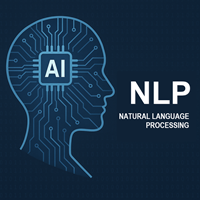AI That Interprets and Generates Human Language is Natural Language Processing (NLP)
Natural Language Processing (NLP) is a truly transformative field. A branch of artificial intelligence (AI) that allows computers to understand, interpret, and generate human language, both written and spoken. By integrating computational linguistics, machine learning, and deep learning, NLP enables seamless connections between human communication and digital systems, transforming our interactions with technology into more natural and intuitive experiences.
How Natural Language Processing (NLP) Works
NLP systems process language through a series of computational techniques:
- Tokenization: Breaking down text into words or phrases for easier analysis.
- Part-of-Speech Tagging: Identifying grammatical roles such as nouns, verbs, and adjectives.
- Named Entity Recognition (NER): Extracting names of people, places, organizations, and other entities from text.
- Sentiment Analysis: Determining the emotional tone of a message, such as positive, negative, or neutral.
- Machine Translation: Automatically translating text or speech between languages while preserving context and meaning.
- Text Summarization: Creating concise summaries from lengthy documents.
- Speech Recognition and Synthesis: Converting spoken language into text and vice versa.
Key Applications of NLP
NLP is already a part of everyday life and business operations:
- Virtual Assistants: Siri, Alexa, and Google Assistant rely on natural language processing (NLP) to understand spoken commands and respond in natural language.
- Chatbots: Automated customer service bots use NLP to interpret queries, provide answers, and escalate complex issues to human agents.
- Email Filtering: NLP helps identify spam and categorize emails for improved organization.
- Sentiment Analysis: Businesses analyze customer feedback, reviews, and social media to gauge public sentiment about their products or services.
- Document Processing: NLP automates the extraction, classification, and summarization of information from large volumes of unstructured text, thereby improving efficiency and accuracy in sectors such as healthcare, insurance, and legal services.
- Language Translation: Tools like Google Translate utilize Natural Language Processing (NLP) for real-time, context-aware translation between multiple languages.
Why Natural Language Processing (NLP) Matters
NLP is crucial for several reasons:
- Enhanced Communication: It enables humans to interact with machines using everyday language, thereby reducing the need for specialized commands and language.
- Automation: Natural Language Processing (NLP) streamlines repetitive tasks such as data entry, customer support, and document handling, freeing up human resources for more complex work.
- Business Insights: By analyzing large volumes of text and speech data, NLP uncovers trends, customer preferences, and emerging issues, thereby supporting better decision-making.
- Multilingual Capabilities: NLP breaks down language barriers, enabling global communication and access to information.
The Future of Natural Language Processing
NLP will continue to be a driving force behind innovations in generative AI, conversational agents, and real-time translation. As AI models become increasingly sophisticated, NLP will make technology even more accessible, personalized, and responsive to human needs, sparking a new era of possibilities.
In essence, Natural Language Processing is the cornerstone of AI’s ability to comprehend and produce human language, facilitating smarter, more intuitive interactions between people and machines.
(NLP): AI That Interprets and Generates Human Language
Natural Language Processing (NLP) is a transformative branch of artificial intelligence (AI) that enables computers to interpret, understand, and generate human language—both written and spoken. By combining computational linguistics, machine learning, and deep learning, NLP bridges the gap between human communication and digital systems, making interactions with technology more natural and intuitive.
How NLP Works
NLP systems process language through a series of computational techniques:
- Tokenization: Breaking down text into words or phrases for easier analysis.
- Part-of-Speech Tagging: Identifying grammatical roles such as nouns, verbs, and adjectives.
- Named Entity Recognition (NER): Extracting names of people, places, organizations, and other entities from text.
- Sentiment Analysis: Determining the emotional tone of a message, such as positive, negative, or neutral.
- Machine Translation: Automatically translating text or speech between languages while preserving context and meaning.
- Text Summarization: Creating concise summaries from lengthy documents.
- Speech Recognition and Synthesis: Converting spoken language into text and vice versa.
Key Applications of NLP
NLP is already a part of everyday life and business operations:
- Virtual Assistants: Siri, Alexa, and Google Assistant rely on natural language processing (NLP) to understand spoken commands and respond in natural language.
- Chatbots: Automated customer service bots use NLP to interpret queries, provide answers, and escalate complex issues to human agents.
- Email Filtering: NLP helps identify spam and categorize emails for improved organization.
- Sentiment Analysis: Businesses analyze customer feedback, reviews, and social media to gauge public sentiment about their products or services.
- Document Processing: NLP automates the extraction, classification, and summarization of information from large volumes of unstructured text, thereby improving efficiency and accuracy in sectors such as healthcare, insurance, and legal services.
- Language Translation: Tools like Google Translate utilize NLP for real-time, context-aware translation between multiple languages.
Why NLP Matters
NLP is crucial for several reasons:
- Enhanced Communication: It enables humans to interact with machines using everyday language, thereby reducing the need for specialized commands and language.
- Automation: NLP streamlines repetitive tasks such as data entry, customer support, and document handling, freeing up human resources for more complex work.
- Business Insights: By analyzing large volumes of text and speech data, NLP uncovers trends, customer preferences, and emerging issues, thereby supporting better decision-making.
- Multilingual Capabilities: NLP breaks down language barriers, enabling global communication and access to information.
The Future of NLP
As AI models become increasingly sophisticated, NLP will continue to drive innovations in generative AI, conversational agents, and real-time translation. This will make technology even more accessible, personalized, and responsive to human needs.
In summary, Natural Language Processing is at the heart of AI’s ability to understand and generate human language, driving smarter, more intuitive interactions between people and machines across numerous applications and industries.

